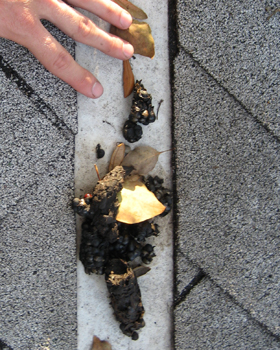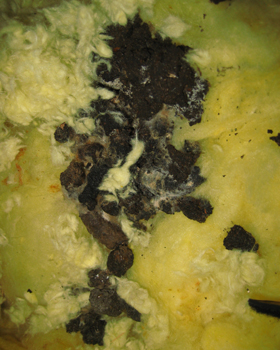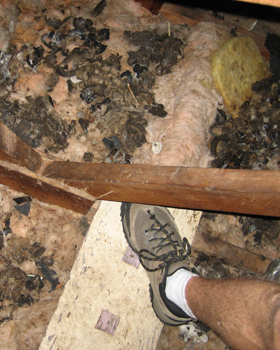How to Identify Raccoon Poop? - We commonly get emails asking to identify feces. One of the best ways is with photographs, so check out the photos to the left. Raccoon poop tends to be in piles,
about 3-5 ounces (maybe 4 inches wide), and the individual turds, if distinct, are usually around 3/4 inch in diameter. Sometimes it is mushy, sometimes firm, and fairly inconsistent. It's more likely to be in a
pile than distinct turds. The droppings are usually very dark brown, but turn ashen with time. One of the easiest tell-tale
signs of raccoon droppings are berries. It's very common to see distinct berries, such as in the photo to the left. Another way to know is by looking for other animals signs - nesting material, footprints, etc. Raccoons tend
to leave very muddy tracks, with distinct fore and hind feet prints.
Is it dangerous to touch? - Almost all animal waste carries risk of disease or infection if handled or ingested. Potential ailments from a variety of animal waste include the more common Leptospirosis or
Salmonellosis (an infection from bacteria called Salmonella) or more common parasites like Giardia, to less common diseases, like Cryptosporidium. Transmission of these diseases is most common when people
handle feces and then ingest them (much more common for children then adults), but open wounds can sometimes be a concern. In general, avoid touching feces of any kind. Read more about raccoon diseases here.
What is Raccoon Roundworm? - Roundworm is the most commonly cited disease specific to raccoon waste. The Latin name for these worms is Baylisascaris procyonis. It is a roundworm that is particular to raccoons.
It is a roundworm that is particular to raccoons. The parasitic nature of B. procyonis is that it lives in the raccoons' intestinal tract. A raccoon can carry on the average a parasitic load of about fifty adult worms in its
intestines. With every fecal movement the raccoon has, he also deposits many of the roundworm eggs onto the ground. The eggs can survive for years, and become airborne, inhaled, and infect a new host.
What Should I Do If I've Touched or Eaten Feces? - Clean your hands thoroughly with antibacterial soap, and monitor for symptoms of illness in the future. If you do develop symptoms, recollecting
that you handled raccoon waste may help narrow down your exact ailment. Treatment of a roundworm or other infection should be handled by a doctor.
Should I Clean It, Or Leave it Alone? - If you think there's a risk of a person or pet coming into contact with the feces, clean it. Even if a raccoon poops in the swimming pool, the chlorine won't kill roundworm
eggs. If you don't clean feces in the attic, it's likely to attract insects, perhaps future animals, and the roundworm spores live a long time. But there's also a good chance nothing would ever happen, so long as you don't touch
or disturb the feces up there. The would get moldy, and eventually dry out, and with a lot of time, crumble into dirt.
How Should I Clean It? - If you do want to clean raccoon feces, wear proper protection. This includes a filter mask, like a HEPA mask, or a snug fitting N95-rated particle mask, either of which you can buy at Home Depot. You do
not want to inhale airborne eggs. Also, wear disposable rubber gloves. Optional is dosposable rubber booties or an eight-dollar Tyvek disposable suit. Once outfitted, remove the feces by hand or shovel, and bag for disposal. Remove soiled
insulation in the attic. Spray the area with an antimicrobial spray, or better yet, fog the attic space with an atomizer and a special enzyme cleaner.
Is it True Racccoons Use a Latrine? - Often, yes. This is basically just a big pile of feces in one spot. Some raccoons eliminate waste this way, while others just leave it around anywhere, like most animals.
What About Raccoon Urine? - While it can soak through insulation or sheetrock in an attic, and cause some slight odor, it is not of any particular health concern.
For effective ways to solve a raccoon problem yourself, or to find local help, click the below buttons:



